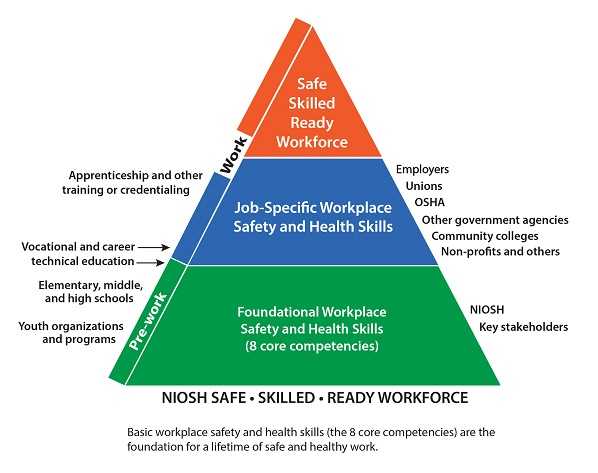Safe • Skilled • Ready Workforce Program
Before they join the U.S. workforce for the first time, or start a new job, all workers will have the basic skills they need to stay safe on the job and to contribute to a safe, healthy, and productive workplace. That is the mission of the Safe–Skilled–Ready Workforce Program of the National Institute for Occupational Safety and Health (NIOSH). The effort recognizes that employers are responsible for providing a safe and healthy workplace, but also promotes the idea that everyone should have basic skills to help protect them and make health-enriching decisions on the job now, and throughout their lives. To achieve Total Worker Health™, all workers must have these critical opportunities. Our nation's economic health—and the health of all of our citizens—depend on it.
Overview
Today's workplaces are complex and are part of a new global economy. They need workers with skills to meet 21st century challenges. The October 2011 interim report released by the President's Council on Jobs and Competitiveness addresses this concern. It states, "In the 21st century global marketplace, a nation's economy can only be as strong as the skills of its people."1
There are many ways to define what "work ready" means in the modern economy. Most agree that workers should have skills in two areas:
- Basic or hard skills (such as reading, writing, and arithmetic).
- Applied or soft skills (such as being flexible; being able to self-direct; and having self-control, accountability, responsibility, and leadership skills).2
Many approaches to developing a modern workplace do not address health and safety skills of workers. Workplace safety and health is therefore the missing "life skill" in many work-readiness skills frameworks.
At NIOSH, our research shows that a "ready worker" is a skilled worker and a safe and healthy worker. The skills that allow workers to contribute to and benefit from a safe, healthy, and productive workplace are therefore key to any work-readiness effort, and to every job.
People who are injured on the job cannot live up to their full potential and cannot play productive, fully functioning roles in the workforce or in our communities. The Safe–Skilled–Ready Workforce Program is built on the idea that safe and healthy work is vital to a worker's well-being.
Please click here for examples of how NIOSH will promote the Safe-Skilled-Ready Workforce Program.

References
1 President's Council on Jobs and Competitiveness [2011]. Taking action, building confidence: five common-sense initiatives to boost jobs and competitiveness. Interim report [ http://files.jobs-council.com/jobscouncil/files/2011/10/JobsCouncil_InterimReport_Oct11.pdf ], p. 31.
2 Partnership for 21st Century Skills [2011]. Framework for 21st century learning [ http://www.p21.org/overview/skills-framework ].
3 The Conference Board, Corporate Voices for Working Families, Partnership for 21st Century Skills, Society for Human Resource Management [2006]. Are they really ready to work? Employers' perspectives on the basic knowledge and applied skills of new entrants to the 21st century workforce [ http://www.conference-board.org/pdf_free/BED-06-Workforce.pdf ].
- Page last reviewed: April 2, 2013
- Page last updated: March 10, 2016
- Content source:
- National Institute for Occupational Safety and Health Education and Information Division


 ShareCompartir
ShareCompartir